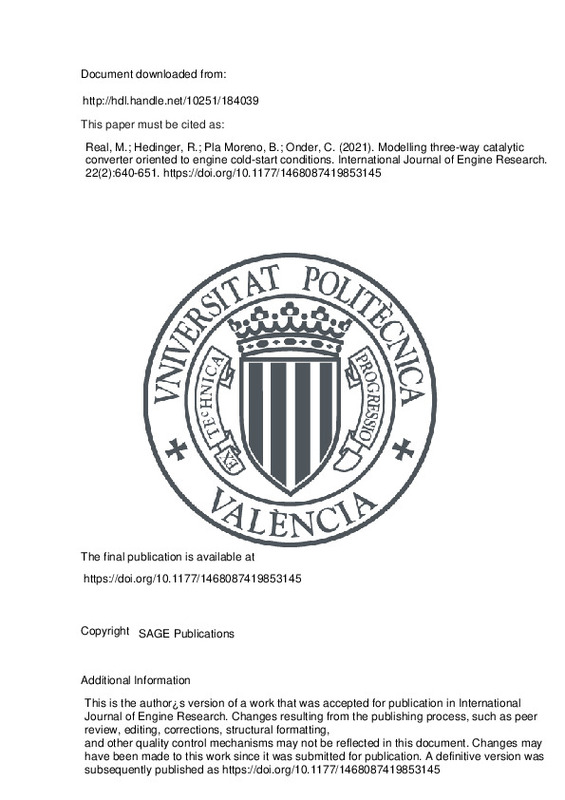JavaScript is disabled for your browser. Some features of this site may not work without it.
Buscar en RiuNet
Listar
Mi cuenta
Estadísticas
Ayuda RiuNet
Admin. UPV
Modelling three-way catalytic converter oriented to engine cold-start conditions
Mostrar el registro sencillo del ítem
Ficheros en el ítem
| dc.contributor.author | Real, Marcelo
|
es_ES |
| dc.contributor.author | Hedinger, Raffael
|
es_ES |
| dc.contributor.author | Pla Moreno, Benjamín
|
es_ES |
| dc.contributor.author | Onder, Christopher
|
es_ES |
| dc.date.accessioned | 2022-07-12T18:04:55Z | |
| dc.date.available | 2022-07-12T18:04:55Z | |
| dc.date.issued | 2021-02 | es_ES |
| dc.identifier.issn | 1468-0874 | es_ES |
| dc.identifier.uri | http://hdl.handle.net/10251/184039 | |
| dc.description | This is the author¿s version of a work that was accepted for publication in International Journal of Engine Research. Changes resulting from the publishing process, such as peer review, editing, corrections, structural formatting, and other quality control mechanisms may not be reflected in this document. Changes may have been made to this work since it was submitted for publication. A definitive version was subsequently published as https://doi.org/10.1177/1468087419853145 | es_ES |
| dc.description.abstract | [EN] This article introduces a physical model of a three-way catalytic converter oriented to engine cold-start conditions. Computational cost is an important factor, particularly when the modelling is oriented to the development of engine control strategies. That is why a one-dimensional one-channel real-time capable model is proposed. The present model accounts for two phases, gas and solid, respectively, considering not only the heat transfer by convection between both, but also the water vapour condensation and evaporation in the catalyst brick, which plays a key role during engine cold-start. Moreover, the model addresses the conductive heat flow, heat losses to the environment and exothermic reactions in the solid phase, as well as the convective heat flow in the gas phase. Regarding the chemical model, the oxidation of hydrocarbons and carbon monoxide is considered by means of the Langmuir-Hinshelwood mechanism. Three layers make up the model structure from a kinetic point of view, bulk gas, washcoat pores and noble metal in the catalyst surface. The model takes fuel-to-air ratio, exhaust gas mass flow, temperature, pressure and gas composition as inputs, providing the thermal distribution as well as the species concentration along the converter. | es_ES |
| dc.language | Inglés | es_ES |
| dc.publisher | SAGE Publications | es_ES |
| dc.relation.ispartof | International Journal of Engine Research | es_ES |
| dc.rights | Reserva de todos los derechos | es_ES |
| dc.subject | Catalyst warm-up | es_ES |
| dc.subject | Control-oriented modelling | es_ES |
| dc.subject | Engine cold-start | es_ES |
| dc.subject | After-treatment systems | es_ES |
| dc.subject | Three-way catalyst | es_ES |
| dc.subject.classification | MAQUINAS Y MOTORES TERMICOS | es_ES |
| dc.title | Modelling three-way catalytic converter oriented to engine cold-start conditions | es_ES |
| dc.type | Artículo | es_ES |
| dc.identifier.doi | 10.1177/1468087419853145 | es_ES |
| dc.rights.accessRights | Abierto | es_ES |
| dc.contributor.affiliation | Universitat Politècnica de València. Departamento de Máquinas y Motores Térmicos - Departament de Màquines i Motors Tèrmics | es_ES |
| dc.description.bibliographicCitation | Real, M.; Hedinger, R.; Pla Moreno, B.; Onder, C. (2021). Modelling three-way catalytic converter oriented to engine cold-start conditions. International Journal of Engine Research. 22(2):640-651. https://doi.org/10.1177/1468087419853145 | es_ES |
| dc.description.accrualMethod | S | es_ES |
| dc.relation.publisherversion | https://doi.org/10.1177/1468087419853145 | es_ES |
| dc.description.upvformatpinicio | 640 | es_ES |
| dc.description.upvformatpfin | 651 | es_ES |
| dc.type.version | info:eu-repo/semantics/publishedVersion | es_ES |
| dc.description.volume | 22 | es_ES |
| dc.description.issue | 2 | es_ES |
| dc.relation.pasarela | S\388553 | es_ES |







![[Cerrado]](/themes/UPV/images/candado.png)

